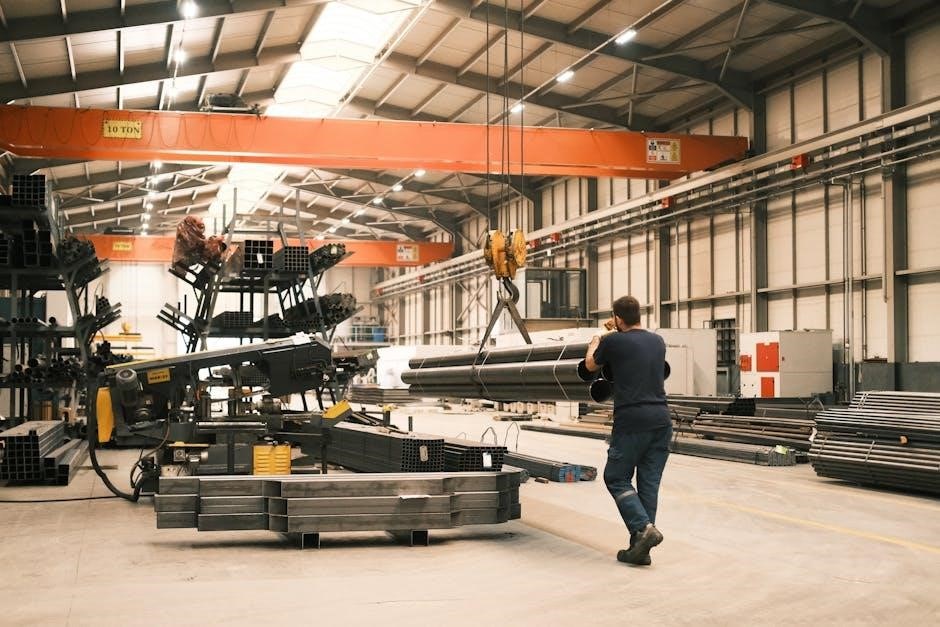Mechanics of Materials, or strength of materials, is a foundational engineering discipline studying internal forces and deformations in loaded structures, essential for designing safe, efficient systems.

1.1 Definition and Scope
Mechanics of Materials, often referred to as Strength of Materials, is a fundamental engineering discipline that examines the behavior of solid objects under various types of loading. It focuses on understanding the internal forces, stresses, and deformations that materials experience when subjected to external loads. This field is essential for designing structures, machines, and mechanical components to ensure safety, efficiency, and reliability. The scope of Mechanics of Materials encompasses analyzing the elastic and plastic behavior of materials, determining stress and strain distributions, and evaluating failure criteria. It is a cornerstone for engineering disciplines such as mechanical, civil, aerospace, and materials engineering, providing the theoretical foundation for practical design and analysis.
1.2 Importance in Engineering Disciplines
Mechanics of Materials is crucial across engineering fields, providing essential tools for analyzing and designing load-bearing structures. It ensures safety, efficiency, and reliability in mechanical, civil, aerospace, and materials engineering. Engineers rely on it to understand material behavior under stress, preventing failures and optimizing designs. The principles are vital for developing infrastructure, machinery, and vehicles, ensuring they withstand operational loads. This field bridges theoretical knowledge with practical applications, making it indispensable for modern engineering challenges and innovations.

Key Concepts in Mechanics of Materials
Stress, strain, and deformation are fundamental, while elasticity and plasticity define material behavior under load. Shear stress and axial loading are critical for analyzing structural integrity and material response.
2.1 Stress, Strain, and Deformation
Stress is a force applied over a material’s cross-sectional area, causing deformation. Strain measures the resulting deformation relative to the original length. Normal stress acts perpendicular to the material’s surface, while shear stress acts parallel. Elastic deformation is reversible, but beyond the elastic limit, plastic deformation occurs, remaining after the load is removed. Hooke’s Law describes the linear relationship between stress and strain in the elastic range. Understanding these concepts is critical for analyzing how materials behave under various loads, ensuring structural integrity in engineering applications. Real-world examples, such as beams under bending, illustrate the practical importance of stress, strain, and deformation analysis in design and safety evaluations.

2.2 Elasticity and Plasticity

Elasticity refers to a material’s ability to return to its original shape after external loads are removed, a property governed by Hooke’s Law within the proportional limit. Plasticity describes permanent deformation beyond the elastic limit, where the material does not return to its original form. The elastic modulus quantifies stiffness, while the yield strength indicates the transition from elastic to plastic behavior. Understanding these properties is crucial for engineering design, as materials must withstand loads without exceeding elastic limits to ensure reliability and safety. Plastic deformation analysis is essential for predicting failure modes and optimizing structural performance under various conditions. This balance between elasticity and plasticity ensures materials are both durable and functional in real-world applications.

Analysis Methods in Mechanics of Materials
Mechanics of materials involves analyzing stress, strain, and deformation under various loads. Key methods include torsion, bending, and shear stress analysis, ensuring structural integrity and safety.
3.1 Torsion and Bending Analysis
Torsion and bending analysis are critical in evaluating structural components under various loads. Torsion involves twisting forces that cause shear stresses, often analyzed in shafts and axles. Bending analysis examines beams and similar structures subjected to transverse loads, leading to normal and shear stresses. These methods ensure components can withstand operational stresses without failure. Real-world applications include engine shafts and building beams. Engineers use formulas like torsional shear stress (τ = Tr/J) and bending stress (σ = Mc/I) to predict material behavior. Understanding these analyses is vital for designing safe and efficient structures across engineering disciplines.
Material Behavior Under Load

Understanding material behavior under load is crucial for analyzing stress-strain relationships, determining elastic limits, and identifying plastic deformation thresholds to prevent structural failure.

4.1 Shear Stress and Strength Conditions
Shear stress occurs when a force acts perpendicular to the length of a material, causing deformation. It is calculated as τ = V/A, where V is the shear force and A is the cross-sectional area. Unlike tensile or compressive stress, shear stress is not uniform across the material. Strength conditions ensure materials withstand shear forces without failure. Engineers analyze shear stress to design beams, shafts, and bolts, ensuring they meet safety criteria. Understanding shear behavior is critical for predicting material failure and optimizing structural integrity in mechanical systems. Proper design under shear loading prevents catastrophic failures in real-world applications. This concept is vital in mechanical, aerospace, and civil engineering. Shear strength conditions are fundamental for ensuring reliability and longevity in engineered components.

Applications in Engineering Design
Mechanics of materials is crucial for designing beams, shafts, and bolts, ensuring safety and efficiency in engineering applications by analyzing stress and strain behaviors.
5.1 Case Studies and Real-World Examples
Case studies in mechanics of materials illustrate practical applications, such as analyzing shafts under torque or beams under bending loads. Real-world examples include determining maximum shear stress in solid shafts and ensuring material strength in structural designs. These studies highlight how engineers use stress-strain relationships to predict material behavior. For instance, in aerospace engineering, understanding elastic limits is critical for designing components that withstand operational stresses without permanent deformation. Additionally, problems involving bolts and fasteners demonstrate the importance of shear stress calculations. These examples emphasize the role of mechanics of materials in ensuring safety and efficiency in engineering designs across various industries.
Resources for Further Learning
Online textbooks, problem sets, and example solutions provide comprehensive resources for mastering mechanics of materials. Websites like MIT OpenCourseWare and Engineering Toolbox offer detailed study materials and tools.
6.1 Online Textbooks and Problem Sets
Online textbooks and problem sets are invaluable resources for studying mechanics of materials. Platforms like MIT OpenCourseWare and Engineering Toolbox offer free, comprehensive materials. These resources include detailed textbooks, practice problems, and solution sets, catering to various engineering disciplines. Many textbooks are available in PDF format, making them easily accessible for offline study. Problem sets often cover topics like stress, strain, and torsion, with step-by-step solutions to enhance understanding. Additionally, some websites provide interactive tools and multimedia content to supplement learning. These resources are particularly useful for self-paced learning and exam preparation, ensuring students and professionals can master the subject effectively. They provide a practical approach to applying theoretical concepts in real-world engineering scenarios.
6.2 Example Problems and Solutions
Example problems and solutions are critical for mastering mechanics of materials. They provide practical insights into applying theoretical concepts to real-world scenarios. Many textbooks and online resources offer detailed problem sets covering topics like stress, strain, torsion, and bending. These examples often include step-by-step solutions, enabling learners to understand the thought process and methodologies used in solving complex engineering problems. Additionally, platforms like Engineering Toolbox and university repositories provide downloadable PDFs with solved problems, catering to various engineering disciplines. These resources are essential for students and professionals alike, helping them bridge the gap between theory and application in mechanics of materials. Regular practice with these problems enhances problem-solving skills and prepares individuals for challenging engineering tasks.
